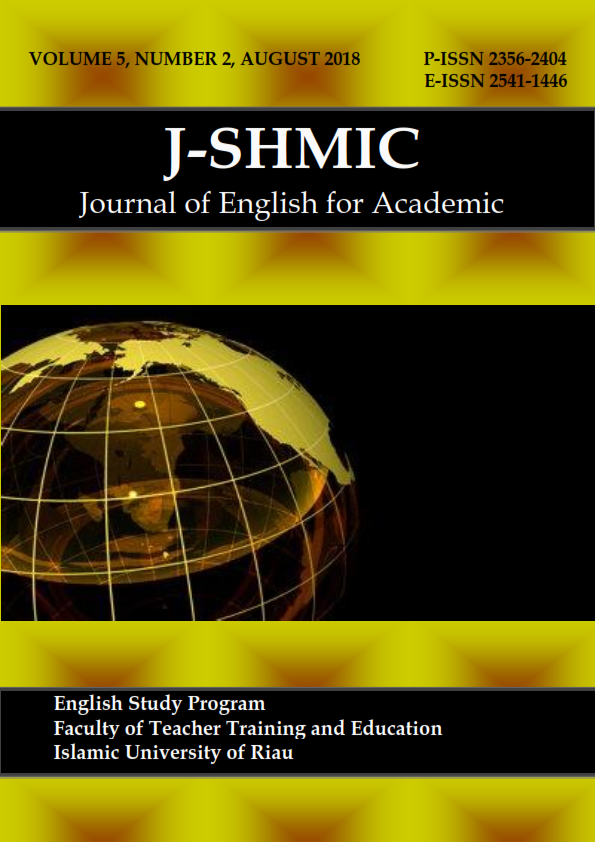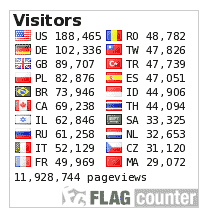Students’ Perception of Using Whatsapp in Blended Learning on Reading
Keywords:
Perception, WhatsApp, Blended Learning, Reading ComprehensionAbstract
This research aimed to investigate students’ perception of using Whatsapp in blended learning on reading comprehension. This was a descriptive research. The participants of this study consisted of 40 students of the second semester at STMIK-AMIK Riau, Pekanbaru, Indonesia. The data collected through questionnaire and interview. The finding of this research showed that majority of the participants had positive perception towards the using Whatsapp in blended learning on reading comprehension. All of the means of students responses in the questionnaire in each items were at 3.5-4.5 which indicated students’ responses were positive or at high level. The result from questionnaire also revealed that students agreed that using whatsapp in blended learning on reading comprehension was useful, helpful and effective in learning English anytime and anywhere. The findings from interview results also revealed that there were positive aspects and drawbacks of using Whatsapp in blended learning on reading comprehension. Nevertheless, the positive aspects of using Whatsapp in blended learning on reading comprehension gave more benefits to the students’ learning activities and their performances. These benefits could be continued to students’ learning outcome especially on their reading comprehension ability.
Downloads
References
Askari-Arani, J. 2004. Internet-based Medical Articles in EMP. ESP World Journal 3/2. Available online at: http://espworld.7p.com/Articles_8/Medical_A%20.htm
Bal, Y., & Arici, N. 2011. Mobile Learning material preparation process. Journal of Information Technology, 4(1), 7-12.
Butler-Pascoe, M.E., & Wiburg, K.M. 2003. Using technology to teach reading and writing. In M.E. Butler-Pascoe & K.M. Wiburg (Eds.), Technology and Teaching English Language Learners (pp. 114-137). Boston, MA: Allyn and Bacon.
Day, R. R and Bamford, J. 1998. Extensive Reading in the second language classroom. Cambridge: Cambridge University Press.
Dreyer, C and Nel, C. 2003. Teaching reading strategies and reading comprehension within a technology-enhanced learning environment. System, 31, 349-365.
Elshenheimer, J. 2006. Got Tolls? The blended learning analysis and design expediter. Centre for integrative Learning Performance Improvement, 45 (8), 26.
Hu, G. 2002. Recent important developments in secondary English-language teaching in the People‘s Republic of China. Language, Culture, and Curriculum 15, 30-49.
Kukulska-Hulme, A. and Traxler, J. 2005. Mobile learning: A handbook for educators and trainers. Cromwell Press.
Kukulska-Hulme, A. 2009. Will mobile learning change language learning? ReCALL 21, 157-165.
Mikic, F., Anido, L., Valero, E., & Picos, J. 2007. Accessibility and mobile learning standardization. Paper presented at The Second International Workshop on MCL 2007.
Rossett, A. (ed.). 2002. The ASTD e-learning handbook. New York: McGraw-Hill.
Russell, T,. Osguthorpe, C.R. Graham. 2003. Blended Learning Environment: Definition and Direction. Review of Distance Education, 4 (3), 227.
Geddes, S.J. 2004. Mobile Learning in the 21st Century: benefits for learners, “Knowledge Tree E- journal, vol.30, no 3, pp. 214-228
Sahin, I. 2007. Predicting student satisfaction in distance education and learning environments. Turkish Online Journal of Distance Education-TOJDE, 8 (2), 113-119.
Singh, D. K. 2007. Effectiveness of online instruction: Online submission. (Online). Retrieved from: www. Eric.ed.gov/ERICWebPortal/recordDetail?accno=ED498987 (Januari 14, 2015)
Trinder, R .2006. ‘Integration of E-learning into a Tertiary Educational Context’, in Arnó, E, Soler, A and Rueda, C (eds) Information Technology in Languages for Specific Purposes: Issues and Prospects. New York: Springer, 191–210.
Warman, Liya Astarilla Dede. 2017. The Effect of Whatsapp in Blended Learning on English as Foreign Language (EFL) Undergraduate Students’ Reading Comprehension. Proceeding of the Fifth International Seminar on English Language and Teaching (ISELT 2017). Atlantis Press.
Young, J. 2002. “Hybrid” teaching seeks to end the divide between traditional and online instruction. Chroncle of higher Education, 48 (28), 33.
Published
How to Cite
Issue
Section
This is an open-access article distributed under the terms of the Creative Commons Attribution-ShareAlike 4.0 International License which permits unrestricted use, distribution, and reproduction in any medium. Users are allowed to read, download, copy, distribute, search, or link to full-text articles in this journal without asking by giving appropriate credit, providing a link to the license, and indicating if changes were made. All of the remixes, transform, or build upon the material must distribute the contributions under the same license as the original.











